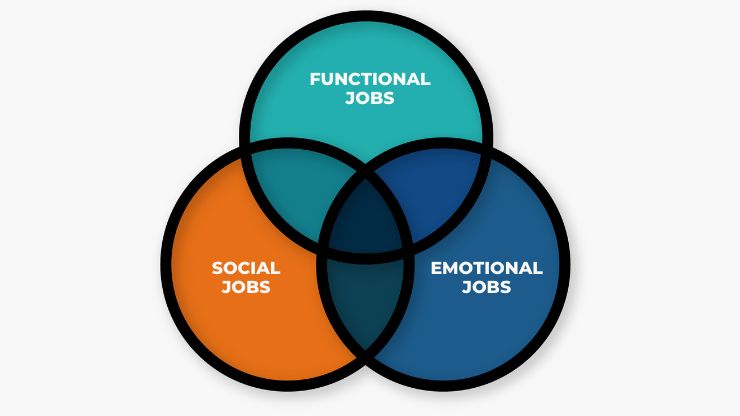How to Write a Management Summary for Your Business Plan
Entrepreneurs are often celebrated for their uncanny ability to understand others – their customers, the market, and the ever-evolving global...
5 min read
![]() Brent Butler
Oct 13, 2022 12:51:51 PM
Brent Butler
Oct 13, 2022 12:51:51 PM

Writing or updating a business plan for an existing business can be rewarding and eye-opening, but you might consider taking a different approach than you did when you were in the startup or early stages.
Back-burner the Four Ps!
Stop discussing market demand!
Rip up the white paper about that consumer segmentation!
Delete that pricey research on market trends from your shopping cart!
These marketing conventions are not how or why today's companies gain the upper hand and sell their products and services; in fact, they probably never were.
Instead, use Jobs-to-be-Done (JTBD) Theory to rethink your competitive advantage and focus on innovating your products, services, and business model.
Key Takeaways
|
A competitive advantage consists of the characteristics or factors that a business possesses that enable its products or services to complete jobs common to customer groups, for which those customer groups hire the product or service, and to do so in a more cost-effective, superior, convenient, or innovative manner than its competitors.
JBTD Theory (also referred to as Outcome-Driven Innovation) arose from Clayton M. Christensen and Steve Ulwick's research, first published in the Harvard Business Review in 2002. The JTBD framework allows you to survey and understand exactly why customers purchase products or services to complete the social, emotional, and functional jobs they need to get done. Understanding and incorporating JTBD successfully will be your competitive advantage, hands down. Of course, this is easier said than done. Social, emotional, and functional jobs are often related and can easily start to overlap with one another. So, why don’t we just start with some basics, shall we?
A product or service that performs a functional job helps the user accomplish something, well, functional. If someone is hungry, a candy bar, healthy apple, full-course meal, or microwave dinner are all products that will serve the function of satisfying their appetite. Functional jobs are usually no-frills. They can have much more specific criteria, like eating a meal that is fast so you can catch a flight on-time, but the baseline pragmatism remains the same. Depending on the circumstances and how specific this customer’s functional needs are (maybe they are also gluten-free and stuck at the airport), limited options may enable premium pricing and the opportunity to establish brand awareness.
Products and services that help people maintain their social lives or status fulfill social jobs. These products could be as basic as deodorant (so that you don’t stink up the whole classroom) or something more complex like trying to find a restaurant that’s good for a first date—not too fancy, not too cheap, and in a nice part of town.
People lead busy, messy lives. There are always emotionally-driven jobs that need to be done like paying the bills, traveling to family gatherings, finding the perfect wedding dress, and all of the other troublesome problems we encounter in daily life that overwhelm us. Customers will constantly seek out products or services that can either accomplish these jobs for them or alleviate the emotional distress that comes with them. Emotional jobs are subjective to the customer and what your product or service can do for them, but they are incredibly powerful. Understanding your customer’s emotional needs will put you far ahead.
Functional, social, and emotional jobs all interact with one another. If you’re attending that gala, for example, you will probably encounter all three. Let’s say you need a new pair of shoes for the event. They must serve the functional job of being comfortable enough to get you through the whole night on your feet. They must serve the social job of being appropriate to the event’s level of fanciness. And, they must serve the emotional job of suiting your unique style so that you feel good and confident about yourself as you mingle.

You won’t know what differentiates you from your competition until you understand why and how clients hire their products and services to complete JTBDs.
Understanding who your competitors are, what they're charging, who they're trying to attract, and how well they're performing is helpful, but it’s only the tip of the iceberg. You must understand from their customers' perspectives.
Obviously, you must be aware of your industry's price norms and what you can charge profitably if you wish to discover the optimal competitive advantage. However, if decreasing your pricing gets in the way of your product or service’s ability to complete customer jobs, destroys your margins, or prevents you from compensating your staff fairly, you should not pursue a cost leadership advantage.
If you’re developing a business plan for purchase of an existing business, ideally you would have the ability to interview past customers during your due diligence phase. This might be difficult, time-consuming, and a bit against the grain for many acquisition processes, and it would need to be spelled out in detail in a letter of intent (LOI), but this type of effort could pay off massively. You could discover that customers have a covert dissatisfaction with the target acquisition products, you might gain understanding of where service or marketing efforts could be improved, or you might even uncover previously unknown areas where you could innovate or grow the target company’s current offering. Either way, using the JTBD framework is the ultimate due diligence activity and I guarantee the perspective you’ll glean will be worth it.
If your business has customers, find out (after the honeymoon phase has passed but before they forget about you) what drove them to "switch" from their previous method of getting the job done (or non-consuming) to yours. What events influenced their journey to your product or service?
Jobstobedone.org is an excellent resource for information on how to conduct these interviews and how to use the information you acquire.
Once you have a thorough understanding of your customers' JTBD and have researched your competitors and their customers, don't be surprised if you discover that your products or services have competitors you never considered. Or it may be that those you assumed to be your most direct competitors were not even considered by your customers. Take a consulting firm as an example; they believed their opponents were other consultants, but it turned out that an online certificate course, a legal pad and pen, and a do-it-yourself mentality were their primary competitors for their core service offering.
This information provides you with multiple possibilities, but they all require you to lean in. If you’re using this information to write a business plan to buy an existing business, make sure you consider financing that allows a budget for the initiatives you’ll take after the acquisition occurs.
Either way, take the initiative and get creative. You can innovate your inbound marketing efforts by delighting prospective customers with remarkable content, tools, and social media that outline your advantages over competitors. You can innovate your products or services to better serve the jobs that customers are hiring for.
To return to the example of the consulting firm, they could create blogs, tutorial videos, and social media that describe the complexity of what they actually do and then emphasize the time savings and sunk costs of mistakes made when a beginner (their prospective customers) attempts to do it themselves. Or, they may use their skills to create their own elearning certification program and pair it with light consulting.
If you want to get the most out of your business, you must take the time to understand JTBD — what products, services, or non-consumption you are actually competing against, and how you can innovate your inbound and outbound marketing efforts or products and services to better complete the jobs your customers require.
Without knowing the factors that pushed and pulled on the consumer while they searched for a product or service to complete the JTBD, your firm cannot operate to its fullest capacity.

Entrepreneurs are often celebrated for their uncanny ability to understand others – their customers, the market, and the ever-evolving global...

Despite growth in sectors like artificial intelligence, venture capital funding has seen better days. After peaking at $347.5 billion in 2021, there...

Most people think of a professional business plan company primarily as a "business plan writer." However, here at Masterplans, we choose to approach...